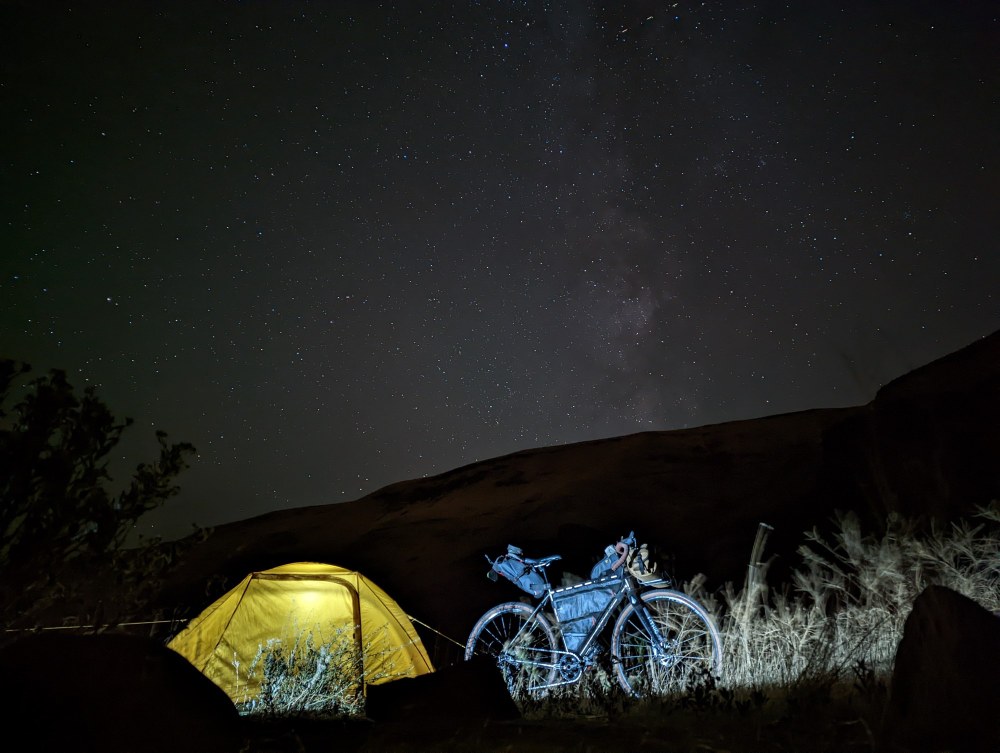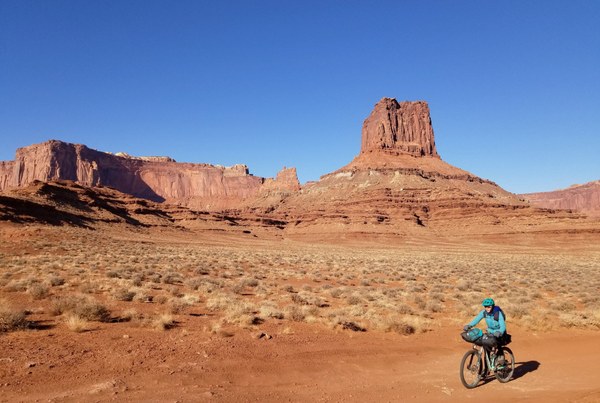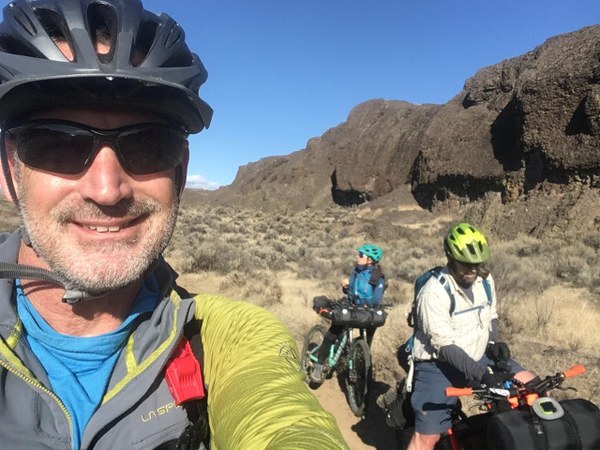
At The Mountaineers, we place great emphasis on experiencing the outdoors in new ways. Scott Schissel and Emma Agosta, Super Volunteers with 39 years of collective Mountaineers membership, are well aware of our community’s zeal for novel experiences. A shared excitement for bikepacking brought their superpowers together.
Bikepacking is a form of bike touring on a mix of trails and gravel roads that combines the adventure and self-sufficiency of backpacking with the speed of biking. During the COVID-19 pandemic, Scott was looking for an activity with an inherently greater degree of physical separation than hiking or climbing, and bikepacking gives you the opportunity to travel farther while staying further apart. Bikepacking also gives you more control over distances. In fall 2020, Scott introduced bikepacking to The Mountaineers and formed the first Bikepacking Committee in Tacoma, launching Tacoma’s inaugural courses.
Emma joined that first Bikepacking Course to take her rediscovered passion for cycling beyond the streets of Seattle and to connect with future bikepacking partners. Tacoma’s foundational course introduced Emma to a community of cyclists eager to take their bikes out of the city and into the backcountry. Inspired, she quickly became a bikepacking leader and established a Seattle Bikepacking Committee in spring 2022.
Aspiring bikepackers can now tap into the dual and shared expertise of Scott and Emma. Students attending Scott's class in Tacoma easily find parallels in Emma's class in Seattle as they approach their courses and committees with a high level of collaboration. The transparent nature of their partnership fosters deep support across both branches and nurtures an organic standardization of instruction.
 Emma bikepacking the White Rim Trail, Utah. Photo by Brian Starlin.
Emma bikepacking the White Rim Trail, Utah. Photo by Brian Starlin.
Backpacking on wheels
Taking a bikepacking course, you’ll quickly learn that bikepacking is just backpacking on wheels. “A true minimalistic camping experience with all of your gear packed strategically on a bike,” says Scott. “You can go further, faster, and farther than if you were on foot.”
Our community of Mountaineers bikepackers comprises individuals with varying cycling experience and even some with previous bike touring backgrounds. It is seldom that they travel on paved roads as their trips are focused on backcountry travel. Whether it be backcountry double track or single gravel trails, bikepackers will be hard-pressed to find a shortage of rides on Mountaineers trips. The possibilities are truly endless.
Many riders learn the hard way that carrying a heavy pack greatly inhibits riding enjoyment. “A more minimalistic kind of setup for overnight gear is necessary for an optimal bikepacking experience,” says Emma. Luckily, bikepacking gear tends to be lighter than traditional backpacking gear because all of the gear needs to fit on a bike. You don't need an expensive bike to get out and explore—the only necessity is a bike capable of handling the terrain stipulated in the courses and trips. A good rule of thumb with bikes from thebikepacking courses: you need to be able to ride 20 to 25 miles a day at the trip-listed pace on a bike that you are capable of doing minor repairs on in the backcountry.
Students beginning the process of purchasing gear will be met with Scott and Emma’s empathy, who help their students navigate potential sticker shock of certain higher-end bikes or uncertainty over indefinite gear purchases. Emma urges participants to "start with the most basic bike you have around, or you can borrow, and use basic gear that can be adapted from other sports.” Both committees are making an effort to be inclusive in their communication about the wide array of bike types, veering away from a narrow scope of acceptable gear and highlighting the creative modifications their committee members make to adapt nontraditional bikepacking bikes into appropriate gravel bikes. Understanding spare parts and how to distribute your weight on different terrain are all part of the basics that Scott and Emma are keen on sharing with everyone—experienced cyclists, those with a budding curiosity in bikepacking, and active individuals from other sports alike.
A great fit for any background
Bikepacking offers the thrill of blending two different activities while having a lower physical impact on your body. Whether you enjoy bikepacking, or if you're seeking out your next riding adventure, bikepacking could be your next new favorite sport. It can also be an opportunity to blend more than just backpacking and cycling. As it is becoming a popular multi-sport option, riders are bringing their skis, inflatable kayaks, and packrafts to explore a greater variety of terrain and landscape. If you’re seeking new experiences, bikepacking may be a great fit.
Looking for a place to start? Check out Sam Hendrix’s “Bike Touring the San Juan Islands” to find useful tips and suggested itinerary details to help jumpstart your next biking adventure.
 Scott bikepacking through Ancient Lakes. Photo by Scott Schissel.
Scott bikepacking through Ancient Lakes. Photo by Scott Schissel.
LEADER PRO TIP: GOALS, EXPECTATIONS, STYLE
To lead a successful trip, start by thinking about your goals, expectations, and style. Use these elements to define the parameters of your trip, then include them in the trip description. Transparently outlining this information allows potential trip participants to understand the elements of your trip and decide if it matches their skills, ability, and interests.
Goals are what you want to accomplish. They are measurable outcomes, and they determine your feeling of success on a trip. If accomplishing something will result in a feeling of success and satisfaction, that accomplishment is the goal, and types of goals can range depending on the trip. For example, your goal could be accomplishing 30 miles in two days, getting to Bellingham in less than 4 hours, or visiting all the bakeries on San Juan Island.
Expectations are how we think things will or should get done. Expectations are actions to be done or avoided. They are not negotiable, and they are often required for success or safety. When listing skill expectations, be specific and quantify where possible.
Style is how you like to do things. Some elements of your style might be negotiable. Style is not necessary for success or safety, but contributes to your enjoyment. Examples could be: starting early because you’re an early riser, making shared dinners, or allotting quiet time for evening reading. Too much divergence in style could be a red flag for incompatibility.
Want to continue expanding your leadership and instruction skills? Check out the Foundations of Leadership and Foundations of Instruction eLearning Courses.
This article originally appeared in our spring 2023 issue of Mountaineer magazine. To view the original article in magazine form and read more stories from our publication, visit our magazine archive.
 Michelle Song
Michelle Song